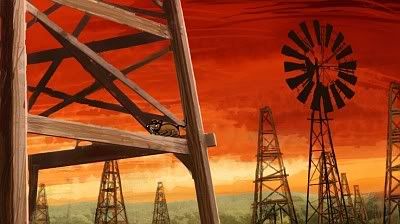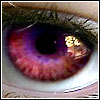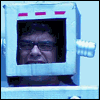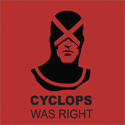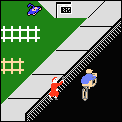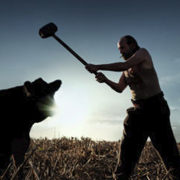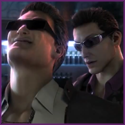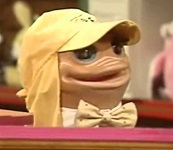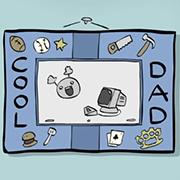|
Defective Detective My graduate film. Hopefully we'll get around to making part 2, but now that everyone's working real jobs it's going to be hard.
|
|
|
|

|
| # ? Apr 16, 2024 18:24 |
|
Hinchu posted:
I'm really liking this, don't really know why though but I really want to see the rest of the movie.
|
|
|
|
Claeaus posted:I'm really liking this, don't really know why though but I really want to see the rest of the movie. Thanks, here you go: http://dl.dropbox.com/u/2064116/Rat%20Episode1f.mp4
|
|
|
|
I posted this over in the CG thread, but I think it may fit better here. I am (attempting to be) a motion graphics designer, and here is my demo reel: http://vimeo.com/9904574 More work can be found on my vimeo page, or at https://www.austinlordmedia.com I've been trying to get more eyes on my work to figure out where I really need to improve, so critique is very welcome.
|
|
|
|
So I'm working with a guy to do a short psudo-trailer for his webcomic. It's going to be 2D animated in the traditional fashion (keyframes, inbetweens, moving plates) but all done digitally. My question is, what is the preferred software to handle this kind of animation from pencil tests all the way to final compositing? He has Flash but we'd rather not use something vector based as he wants retain a traditionally illustrated/painted look like he gets in Photoshop doing his comic. Similarly, Toon Boom uses vectors and does not retain the exact contour of lines drawn in it. I checked out DigiCel Flipbook but it's got a clunky interface and is very limited. I also gave Plastic Animation Paper a shot but it is similarly restrictive and neither of those programs support motion tweening which we need for moving individual elements and layers around. So what are we looking for? Is there an "industry standard"? Are multiple programs usually employed to do this kind of work?
|
|
|
|
Pibborando San posted:So I'm working with a guy to do a short psudo-trailer for his webcomic. It's going to be 2D animated in the traditional fashion (keyframes, inbetweens, moving plates) but all done digitally. Here's a short graduate film I helped out on (I colored the dog animation in Photoshop) using roughly the process I just described. I can give you more details if you like. The animation was done on paper and scanned though, so if you're planning to do it digitally, the process might be slightly altered... But After Effects will handle pretty much everything after the coloring stage. http://www.youtube.com/watch?v=GBGACBGenG0
|
|
|
|
I posted this a while ago in the South Park thread in TV/IV and people have responded pretty positively about it. It's a humorous take on the whole "you can't show Muhammad" controversy surrounding episodes 200/201. It's the first (and currently only) animation I've ever done, and it was all done with manipulating layers in Photoshop and plugging them in frame by frame to Windows Movie Maker. https://www.youtube.com/watch?v=lq6TYDsSuc4
|
|
|
|
Automatic Jack posted:I go to animation school and we use Flipbook for pencil testing, Photoshop (some use FB) for clean-up, After Effects for compositing individual scenes and Premiere for putting it all together with sound and whatnot. Some use Flipbook for coloring but I think it's kind of janky, so Photoshop is a decent bet, though there's probably better programs out there. Wow, that was really well done. The line quality looked a little "rough" similar to old Disney movies like 101 Dalmatians when they were photographing the animators' pencil lines directly to cells. Is that similar to how this was done, or did they "ink" over the scanned drawings in Photoshop? Good news about After Effects and Premier as this guy's got the whole Adobe suite, but I've never used AE so I'll try to find some tuts.
|
|
|
|
Automatic Jack posted:http://www.youtube.com/watch?v=GBGACBGenG0 God, this is so amazing. Pixar job well earned.
|
|
|
|
Automatic Jack posted:I go to animation school and we use Flipbook for pencil testing, Photoshop (some use FB) for clean-up, After Effects for compositing individual scenes and Premiere for putting it all together with sound and whatnot. Some use Flipbook for coloring but I think it's kind of janky, so Photoshop is a decent bet, though there's probably better programs out there. Can you talk a little bit more about paper->Flipbook->Photoshop etc workflow?
|
|
|
|
This isn't nearly so impressive, but I thought I'd share anyway. It's an Earthbound music video in progress that I started as a summer project. Just a fun little exercise to practice using Flash which I've been learning for the first time at my internship. I'm more of a storyboarder than an animator, so the character animation is pretty functional, but it's been fun. (PS Crank it up to 1080p!) FLAVOR TEXT: As someone mentioned, the guy who did that short went straight to Pixar's animation department after graduation since they needed animators for all the dog scenes. I visited him up at Pixar HQ last summer when he was working on Toy Story 3. This year I got shortlisted for a Story internship there, but didn't quite make it; I'm actually kind of glad because I kind of wanted to relax after the busiest school year of my life, and I can always try again next year. They did just open up a Canadian studio too, which is another option I suppose. Pibborando San posted:Wow, that was really well done. The line quality looked a little "rough" similar to old Disney movies like 101 Dalmatians when they were photographing the animators' pencil lines directly to cells. Is that similar to how this was done, or did they "ink" over the scanned drawings in Photoshop? neonnoodle posted:Can you talk a little bit more about paper->Flipbook->Photoshop etc workflow? EDIT: You might also ask Hinchu as it looks like there was a fair amount of AE in that mouse short. AJ'S RIDICULOUSLY COMPLICATED-SOUNDING GUIDE TO ANIMATION, THE PAINFUL, UNINTUITIVE, BUT SADLY EFFECTIVE WAY STEP 1: CHARACTER ANIMATION. The character animation was done classically, both roughs and clean-up in pencil on animation paper, using a light disc and peg bar. One difference though is that the guy (I'll call him V- his name is prolly in the credits) did his roughs in red animation pencil and then cleaned up with dark graphite directly over top on the same sheet of paper. This saves paper and there's a way to get rid of the red after in Photoshop later. ***The ONLY thing we used Flipbook for in this case was pencil testing, i.e. a quick and dirty way of seeing how our rough animation was looking so we could fine-tune it. Some people use it for compositing and coloring but eff that noise. I did color in FB for my 3rd year film but I'm going to focus on how V did his film. You'll notice there's some cel-shading being done in that short. The shadows were done on separate pieces of paper and consisted mainly of a single line on each frame in red pencil. I'll talk about that later. STEP 2: SCANNING. All the penciled frames were scanned into the computer using a pretty fast industrial-sized flatbed scanner. Funnily I remember watching 101 Dalmations while I was scanning. You tape a peg bar to the scanner WHICH SHOULD NEVER BE MOVED UNDER ANY CIRCUMSTANCES or else the frames will be out of synch with each other, and even if that happens to one frame it will be a major pain to correct. You might as well do the whole thing over if that peg bar goes crooked in the middle of scanning frames from the same scene. I think 300 dpi was the resolution used, but it depends sometimes on the field you're using. Also if you're coloring in Flipbook, it can't handle filesizes that are excessively large. One dangerous trick that V taught me was to just keep scanning into Photoshop until all your frames are in the program, then Quit Photoshop and just hold down Enter when it prompts you to save. You'll cycle through all the open files and end up with a huge pile of Untitled PS files with chronological numbers on the end. Use Adobe Bridge to Batch Rename everything to fit your project, like dogmovie_sc04-fr00001.psd onwards or something. STEP 3: CLEANING THE CLEAN-UP. Here's where things get subjective. You gotta familiarize yourself with Actions or you'll go insane. Open a random frame and use it to calculate an Action to, say, adjust brightness and contrast, remove the red rough pencil lines from under your clean-up, get rid of speckles, crop if needed, get rid of the white pixels so only the black lines remain on a transparent background, etc. I won't go into everything in detail unless asked specifically, but here's some helpful tips: -There is a free PS plugin called GHOST that turns all white pixels transparent as well as any shades of gray, so that your lines will remain intact while everything else disappears. You can download it a bunch of places and it's not hard to Google. I think it was programmed by Flaming Pear, and it's bundled with a bunch of other free plugins on their site. -If you used a colored pencil to do your roughs (red seems to work best for this), go to Hue/Saturation and select Red (or whatever color you used) from the drop-down menu and set up your parameters accordingly with the color sliders. Then just crank the Lightness slider up to max and watch those rough lines disappear! Then you can probably Desaturate everything and Adjust Levels and whatnot to get rid of any remaining gray bits. After you figure out the steps to making that one frame look as good as it can get for coloring, you can use Batch Processing to apply all those steps to every frame in a specified folder, thus saving you a buttload of work. Always remember to keep the original files in case something goes wrong the first time, which it almost always does. There is a lot that goes into this step but I'm just glossing over it for the sake of brevity; feel free to ask questions after. STEP 4: COLORING. Now while our teachers always tell us to color in Flipbook, I find the results to be kind of hideous if your clean-up isn't pitch perfect. I've colored in both programs, and Photoshop definitely allows for more precision, although it is much slower. First of all, you have to get all your frames in one PSD file with every frame having its own layer. I'm guessing V made an Action for that as well, or some kind of fancy Importing technique. Anyway, every scene should be a single PSD file with every frame being its own layer. You'll want to sort out your palette ahead of time. An easy way to block in color is to use Actions to, say, select the area outside of the drawn character with the Wand tool being clicked in an area of the frame where no animation in the entire scene will go, then Invert the selection and Fill with some common color on a layer underneath the linework. Blah blah, it sounds complicated but I'll go over it in more detail if people are curious. Suffice to say that you have to think like a computer and tell it in excruciating detail what you want done for the Action tool to be effective. Once you get the hang of it, it's pretty easy though. Once you have color blocked in, you pretty much have to go in by hand and fill in all the nose parts in every frame, eyes, ears, etc. THIS IS WHERE HAVING GAPS IN THE LINEWORK WILL BITE YOU IN THE ARSE. V had his share of these and I'd have to correct the frames by hand, which is just something you're going to have to do. There aren't too many shortcuts for this part. It's essentially click and fill, click and fill, etc. STEP 4.5: SHADOWS. So those red pencil lines I talked about earlier. They pretty much just acted as a guideline; you slap them over top of the corresponding frames of animation, then click and fill with a darker shade of the color underneath. Then you scrap them afterward. I don't remember the specifics but I'm pretty sure it was simply that every other layer in the PSD file was a shadow line. So it would be something like layer 1=animation frame 1, layer 2=shadow line for frame 1, layer 3=animation frame 2, layer 4=shadow line for animation frame 2, etc. It just alternated back and forth. I used the Animation taskbar to turn them all off when I didn't need them... Oh the Animation taskbar... that's a whole other story entirely... STEP 5: EXPORTING PNGS. Once everything is colored, you gotta export every frame as an individual PNG. I don't remember the exact steps for doing this but I think it's pretty simple. As long as you make sure the area around your animation is transparent (in Adobe lingo they call it "alpha channel") and that sort of thing. So you've got this massive stack of PNGs... Whaddya do with them? (NOTE: From what I recall there is a step in this process that involves doubling every frame that is supposed to be on twos. Those who know classical animation should know what that means. Because AE is going to treat every frame as a frame held for 24th of a second, if you have frames on twos, you need duplicate PNGs of that frame. Once again I don't recall exactly how I managed to do this for my projects, but it involved some planning and concentration on my part. Maybe I'll ask V for clarification. Anyway, heads up on that. STEP 6: AFTER EFFECTS. Time to combine your animation with your BGs! Your BGs should all be PNGs too. Everything you do with Premier and AE will likely be PNGs. I don't have the software running so I don't recall the exact steps, but you have to import your animation as a PNG SEQUENCE. Look it up; it's as simple as selecting the first file in the batch when importing and checking off a box that says PNG Sequence, or selecting all the files and checking off a box, or something. It's super easy. Basically it takes your PNGs and treats them all like a single element instead of a bunch of different frames. So in AE, you can just move it around, re-size it, etc. instead of manually changing every frame to match the others (an impossible task). If you want to move out of your house, you put things in boxes to make them easier to relocate. Same principle. AE is pretty easy to learn if you know Premiere. Now all you're doing is compositing the scene, the ease of which depends on how well you planned things out at the beginning. Basically you're putting the puzzle pieces together in a very logical manner: Background elements go in the back, maybe you have some poles moving in the foreground, that's all a matter of setting up two keyframes and motion tweening the rest. There's not much I can say that a good tutorial won't tell you, but you can try to ask me something if you really have no experience with it. Flash operates the same way with less flexibility. STEP 7: PREMIERE. You basically repeat Step 6, except instead of exporting just your animation as a PNG sequence, this time it's your entire scene, BGs and all. Pop that sucker into Premiere with the other scenes and slap sound over top, and you're done. Simple! Now it's time to give up animation forever and become a sheep farmer. I could go into more detailed versions of each step but there's only so much I can talk about a technical subject like this. I'm still pretty much a greenhorn, this is all based on observation and personal experience. I myself don't know nearly as much about AE as I'd like. In the end I personally prefer to wing it, which is why so much of the above stuff sounds so messy. Necessity is the mother of knowing which button to press. I basically glossed over everything, but it will give you an idea of the hell that is one man making a four-minute animated short about a dog who wants his doll back. Again, questions are welcome, though my helpfulness will probably be limited if I can't be in the room explicitly pointing to what menu to click on... And probably someone here knows a way easier way to do some of this stuff. Automatic Jack fucked around with this message at 02:33 on Aug 24, 2010 |
|
|
|
Automatic Jack posted:loving awesome This is great. Thanks for taking the time to outline the whole process. Since I've only done rough animation experiments myself as well as inbetweens on cleaned up stuff, I am wondering if you could elaborate on the process of refining something rough, like this, to something clean, like this. Basically, I'm wondering how closely one usually sticks to the roughs or if it's more of an adaptive process. Also, I'm assuming the clean lines are usually done on a blank sheet on top of the rough one? Sounds like your team had decided before hand to use the same sheet, hence the roughs being done in red pencil. Why was this exactly? Also inbetweens are only done once the keyframes are cleaned up, correct? Thanks.
|
|
|
|
That brings a lot of memories from my sophomore year. We had to do the exact same process with the difference that instead of painting in PS we imported everything into Toon Boom, transformed the lines to vectors, colored and composed it in there.Pibborando San posted:This is great. Thanks for taking the time to outline the whole process. The roughs are more about the general shape and timing of everything. Once you get that settled you can refine it further and do a batch of inbetweens if your keys are very spread apart that details don't have a chance to overlap if your drawings are too rough. Once you get that you have to clean up the keys so you can get the more precise inbetweens. For the line quality you want the lines to be perfectly smooth and opaque. Especially wherever lines connect. Maybe my teacher was being a perfectionist but he also asked for line thickness variation. For the clean ups you can either put a new paper on top or draw over colored pencil. You just have to be careful not to draw too hard with colored pencil because it can still show through even after photoshop.
|
|
|
|
Chernabog posted:...you can refine it further and do a batch of inbetweens if your keys are very spread apart that details don't have a chance to overlap if your drawings are too rough. Could you elaborate on this? This is still before the refining stage correct?
|
|
|
|
It really depends on each case. For example, if you have a character running, his motions are fast and broad and will take less frames. So you can inbetween more without cleaning up because the general placement of the body is the important part. Maybe even do all of it before cleaning up. If you have a character idling over a large number of frames his movement is going to be slow and small, so you pretty much need to clean it up first to be accurate in the subtle line variations. Edit: It is also a good idea to clean up the keys early to make sure that your character stays on model. Chernabog fucked around with this message at 07:38 on Aug 24, 2010 |
|
|
|
Automatic Jack, would you possibly have a high rez picture of that scene with the camera panning across all the Threed baddies I could use for a background because that picture is just too awesome.
|
|
|
|
A Frosty Beverage posted:Automatic Jack, would you possibly have a high rez picture of that scene with the camera panning across all the Threed baddies I could use for a background because that picture is just too awesome. As for clean-up, fun fact: Glen Keane never cleans up his own stuff. I don't know if he could if he tried. Clean-up is an art in and of itself, so your question as to whether it's basically tracing or adaptive, I'd say definitely the latter. Line quality is probably the biggest problem I see with student work; bad clean-up will KILL good animation, no matter how nice the roughs looked. If you're trying to show off animation for a portfolio piece, it's almost always better to leave it rough. If you're actually doing a film though, either have really good clean-up artists, or figure out a process to make up for it like cleaning up digitally or something. Aside from everything Chernabog said (all good advice), I had a bunch of online resources, some from old Disney masters, on the subject. I'll see if I can't dig up the links, but sites like Animation Meat and such are probably where they are now. For a perfect example of clean-up taken to the extreme, check out the slow-motion horseback sequence in The Thief and the Cobbler where the wounded warrior is riding away with all the arrows sticking out of his back. Now, to make something go in slow-motion in hand-drawn animation, a normal person would probably put each frame on twos or even threes, fours or sixes. But Richard Williams insisted that EVERYTHING was to be one ones, even the horse moving at five times reduced speed, so the poor clean-up artist had to divide her lines down to a hair's width to fit in all the in-betweens.
|
|
|
|
Man, I absolutely ADORE the Thief and the Cobbler. I would be happy if I could make something half as technically proficient as that.
|
|
|
|
Is the Thief and the Cobbler worth seeing? I read Richard Williams' animation book which was really good, but the movie looks like a bad Aladdin rip off from the trailer.
|
|
|
|
Hinchu posted:Is the Thief and the Cobbler worth seeing? I read Richard Williams' animation book which was really good, but the movie looks like a bad Aladdin rip off from the trailer. You've got that backwards: http://hubpages.com/hub/An-Unfinished-Dream Article posted:The Thief was to be Williams' life work, his magnum opus. He worked on it for the next twenty years on and off. He often did commercials and other features such as Raggedy Ann and Andy to pay for his pet project...By this time, however, it was discovered that Disney, after seeing Williams' work on The Thief when he was showcasing his work for Roger Rabbit, had "borrowed" several of Williams' ideas and made Aladdin instead
|
|
|
|
Hinchu posted:Is the Thief and the Cobbler worth seeing? I read Richard Williams' animation book which was really good, but the movie looks like a bad Aladdin rip off from the trailer. It's good in theory. There's no doubt that the animation is technically without equal. But it's exhausting to watch and doesn't really have a heart, in my opinion.
|
|
|
|
It's a must-see for animation enthusiasts, but the production problems are excruciatingly obvious and the story doesn't make a whole lot of sense. It's still pretty incredible from a technical standpoint, though. Oh, for the guy who asked:  Click here for the full 1024x768 image. Also downloadable here. Still not as up-rezzy as it could be, but maybe someday.
|
|
|
|
Hot drat, thanks a ton, man! Gon' maybe blow this up a touch, but I got me a new background.
|
|
|
|
Ah, I originally thought that it was Disney taking his idea, but then the dates were off. That makes sense though. There's a "Recobbled" cut. I'll have to check that out. I loved his book.
|
|
|
|
I've been working on this for a few weeks now and could use a set of fresh eyes: http://www.youtube.com/watch?v=uKY1YxRrvms Still a WIP, the lip sync is very rough, as are few other obvious bits. Any and all critiques welcome, though big acting changes aren't really going to be too helpful at this point.
|
|
|
|
The Third Man posted:I've been working on this for a few weeks now and could use a set of fresh eyes: On the kid you have a bunch of abrupt starts and stop, especially on the facial expressions. If you eased those in and out I think that would help a lot. And also I think you need more of a beat when you go back to the doctor for the reaction. I missed it and had to rewind.
|
|
|
|
Yeah, I layed in those expressions pretty quickly this morning and they are too fast. How do you feel about the first section, where the line is "...or any member of your family..."? The characters head is remaining fairly static as he's leaning forwards, and it's kind of bothering me. In the reference I shot I wasn't moving my head at all and it didn't stand out like it does now. Is it just me, or does that section need something?
|
|
|
|
The Third Man posted:Yeah, I layed in those expressions pretty quickly this morning and they are too fast. How do you feel about the first section, where the line is "...or any member of your family..."? The characters head is remaining fairly static as he's leaning forwards, and it's kind of bothering me. In the reference I shot I wasn't moving my head at all and it didn't stand out like it does now. Is it just me, or does that section need something? If anything it needs less. Things like shaking his head after he says "you", and the movement while looking at his pencil (especially his downwards head look on the word "diagnosed") don't read and don't really make sense and it's just too busy, for no apparent reason. You have his hand and pencil awkwardly passing over his mouth at one point too, which makes reading either of those two things harder. I'm not understanding why his hand stops before touching the paper at the start, or why the pencil hand has an awkward w shaped curve to it. His voice sounds bored as well, so slow down that eye blink and make the movements simple and clear, use the timing of his actions as emotions. If he is bored, he's going to be moving his hands lethargically and they're going to be heavier and the timing & arcs need to reflect that. Also watch out for shot continuity. The pose of the doctor at the end of the first cut has his hand down on the paper ready to write. Then it cuts back to him and his arm is back up in the air again, forcing you to move his hand in order to check the paper which also forces you to make him look down to see where he's putting the pencil. If you keep the pencil on the paper at the cut, then he can say "i'd call that a big yes.." and he can check the box on the paper without him looking away from the mental guy running off, which is more entertaining. The contrast in the shot of the doctor's acting should be "bored, not looking at the patient, routine medical question" to "cant. look. away. what a mentalist" So exaggerate the acting to make those sorts of entertaining contrasts really read. Keep it simple and concentrate on the fundamental point of the scene, rather than "can i add more movement here?".
|
|
|
|
The Third Man posted:Yeah, I layed in those expressions pretty quickly this morning and they are too fast. How do you feel about the first section, where the line is "...or any member of your family..."? The characters head is remaining fairly static as he's leaning forwards, and it's kind of bothering me. In the reference I shot I wasn't moving my head at all and it didn't stand out like it does now. Is it just me, or does that section need something? Maybe for a gag when the kid looks up, have him hold there and have one of the pencils slowly fall out of his nose. Then go into that quick action of him picking up the cup and running. Or did you mean the part with the doctor?
|
|
|
|
http://www.mentalfloss.com/blogs/archives/65659 Hey check it out, mental_floss is featuring my Adventures of Mr. Rat animation  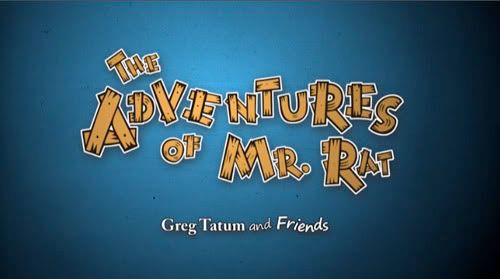
|
|
|
|
Ok, I need to finish this off as best as possible this week and I'm looking for some more critiques. My mentor really wanted the crazy dude to get off screen really fast, even faster than what I just uploaded now so that's getting sped up this week. My other main goals are getting my lip sync right, getting the eyes/brows working together better, and polishing up my arcs, but I'd love some fresh eyes on other parts of this that could use more attention. http://www.youtube.com/watch?v=ufBh1Qte_Ec
|
|
|
|
Hello, world I do not do much "complete" work (as of the time of posting) but when it is 3am in the morning and I am deeply in a state of sleepiness and isolation I will produce something for that time, and recently, that time only, with great effort. barfbarfbarf.swf walkcycle1.swf walkcycle2.swf queee.swf hellobuddy.swf In sudden retrospect, I have produced nothing worthwhile, so I bought The Animator's Survival Guide and wait attentively for it.
|
|
|
|
Hey guys & gals, I'm looking for a few good co-conspirators who might be interested in collaborating. I'm going to start working on some 30 second to 1 minute 2d animations, something similar to the length of my Mr Rat animation, but without the fact gimmick on it and in a different style. I'm thinking of production times taking 1 month to 2 months of work in my spare time per mini-short. My initial concept is to do more traditional painted backdrops, and utilize a book I have of traditional folk tales for inspiration. The shorts would be character and story driven. I'm planning on doing the linework on paper, and then assembling and coloring everything in the computer. I'm thinking more in terms of Lion King in the mix of digital effects, and traditional look and feel. Anyway this is an excuse to have some fun, and make some cool poo poo. I'm open for collaboration on any part of the project from concepts, story, storyboards, animation, coloring, etc. If anyone is interested PM me or gmail me at tatum.creative.
|
|
|
|
I have an animation/art blog at crocolile.blogspot.com Also just uploaded my reel on Vimeo: http://vimeo.com/17930610 Despite having more 2D experience I really want to do stop-motion. Too bad I'm better at building my puppets than animating them... but at least I know how to build them. I just graduated from school and I'm going to go back to the basics and practice like crazy.
|
|
|
|
those look great 
|
|
|
|
I got hugely into animation during uni even if I was pretty crap at it. However, since july I haven't really done anything at all  Here's two unfinished shots from something I was working on back then. Here's two unfinished shots from something I was working on back then.http://www.youtube.com/watch?v=eFJvmTrwwM0 - Climbing http://www.youtube.com/watch?v=_BcDL0YF96U - Getting to the top Both are like, 5~ seconds and i'm really happy with the smoothness of the second one, but I never got around to actually drawing the character in properly  2011 is going to be my year of re-animation. 
|
|
|
|
I'm basically just posting my degree project wherever it's applicable. It's about 5 minutes long and I completed it as my senior year thesis at RISD where my major was Film/Animation/Video. It's a reinterpretation of the 7 days of Creation, with God as a jeans-and-tshirt dad, Lucifer as an office lackey, Jesus as a whiny teenager, etc. and it was mostly meant to get various religious and non-religious types to find some common ground where they normally find none, not to call anyone right or wrong. Any response or non-response is welcome. I'm happy to hear critiques, although I'm not ever going to work on this again. Share it with your friends if you like it, I guess? Thanks for watching! 'In the Beginning' (More of my art and stuff is at my blog.)
|
|
|
|
I've already whored my film Hamsterman earlier in this thread, and more recently in GBS's Youtube thread, but I figured I should bring it up one more time so I can get some input on an idea I have for a series based on the "kid" character (who I have not yet named). The premise of the series is based on experiences I'm sure we've all had as kids when we've encountered creepy people. They either looked, acted, or talked weird in some way, and our parents forbade us from interacting with them - or at least from staring. So basically the series is about this kid who has the bad luck to constantly find himself in situations involving creepy individuals. Hamsterman more or less provides a rough outline for the plot structure of each episode. The kid finds himself, generally against his will, in a situation in which he has to interact with - or avoid - some seemingly scary adult character. The middle section would mainly be a bunch of gags involving the kid and the creepy person(s), which would get increasingly outlandish. The punchline for each episode would be a sort of "twist," if you will, and the kid either has some happy rewarding ending OR finds out he let his fear get in the way of a happy rewarding ending. Of course, that's all subject to change, but it's what I got so far. I was proud of Hamsterman when I made it 3 years ago, but its flaws become more and more apparent to me as time goes on. However I feel like it at least laid the groundwork for something potentially awesome. If I do make it a series, I want it to be legit. I want character development, stellar voice acting, a love interest, animation twice as good as Hamsterman's, creepy characters that are at times more realistic and less "wacky" than the Hamsterman character, solid plot structure and relevant non-random humor. In order to meet all these criteria, I'll need a lot of feedback and criticism, because I know there's no way in hell I can do it all on my own. Here's a short list of possible plots I've thought up with a friend: - Christmas episode: Kid wants awesome toy, goes to mall to talk to Santa. Santa turns out to be incredibly shady. Maybe turns out to actually be Santa. - Nursing home: Kid has to visit scary old great-grandmother at the nursing home. Probably will at some point have to make his way through horde of creepy old people in the hallways (think nurse scene from Silent Hill movie). - Babysitter: Kid's parents are going out. They have to leave before the babysitter arrives. Kid expects usual babysitter - his love interest, a cute older girl. Turns out to be a man with a horribly burned face (picture). - Something involving a school janitor - Homeless guy appears in kid's treehouse - Carnies - Summer camp Again, any and all feedback would not only be appreciated, but absolutely required if I want this to be successful. Thanks in advance.
|
|
|
|
So after I finally got my poo poo together and made a new reel I forgot to post it in here. https://www.youtube.com/watch?v=odMqaMLd_kk
|
|
|
|

|
| # ? Apr 16, 2024 18:24 |
|
Forgot about this thread.Nate Breakman posted:So after I finally got my poo poo together and made a new reel I forgot to post it in here. That "cool guy" thing at the start pops so fast I thought it was a mistake at first. I'd rearrange some stuff with the understanding that a lot of reels don't get viewed until the end. Don't be afraid to front load. Also if you're 2D, you might want to remove the 3d entirely or put that at the back end as like "here's what else I do" bonus. Also might want to tighten up the edit on stuff where you have a long pause before any movement
|
|
|




